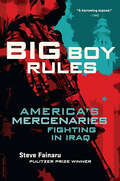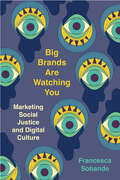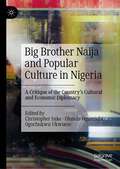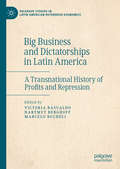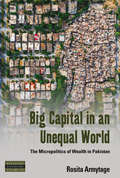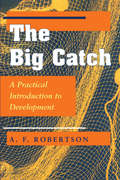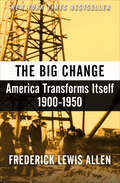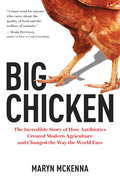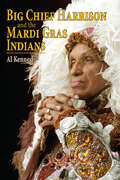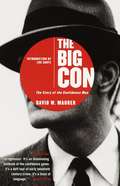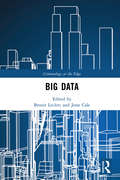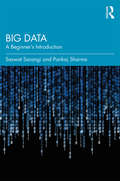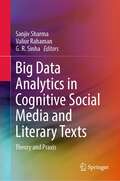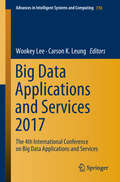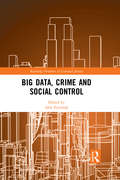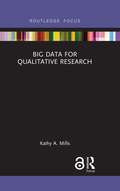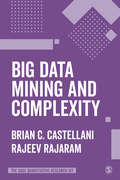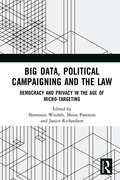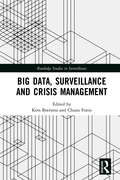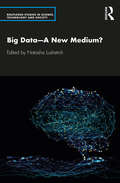- Table View
- List View
Big Boy Rules: America's Mercenaries Fighting in Iraq
by Steve FainaruThere are tens of thousands of them in Iraq. They work for companies with exotic and ominous-sounding names, like Crescent Security Group, Triple Canopy, and Blackwater Worldwide. They travel in convoys of multicolored pickups fortified with makeshift armor, belt-fed machine guns, frag grenades, and even shoulder-fired missiles. They protect everything from the U.S. ambassador and American generals to shipments of Frappuccino bound for Baghdad's Green Zone. They kill Iraqis, and Iraqis kill them. And the only law they recognize is Big Boy Rules. From a Pulitzer Prize-winning reporter comes a harrowing journey into Iraq's parallel war. Part MadMax, part Fight Club, it is a world filled with "private security contractors"--the U.S. government's sanitized name for tens of thousands of modern mercenaries, or mercs, who roam Iraq with impunity, doing jobs that the overstretched and understaffed military can't or won't do. They are men like Jon Coté, a sensitive former U.S. army paratrooper and University of Florida fraternity brother who realizes too late that he made a terrible mistake coming back to Iraq. And Paul Reuben, a friendly security company medic who has no formal medical training and lacks basic supplies, like tourniquets. They are part of America's "other" army--some patriotic, some desperate, some just out for cash or adventure. And some who disappear into the void that is Iraq and are never seen again. Washington Post reporter Steve Fainaru traveled with a group of private security contractors to find out what motivates them to put their lives in danger every day. He joined Jon Coté and the men of Crescent Security Group as they made their way through Iraq--armed to the teeth, dodging not only bombs and insurgents but also their own Iraqi colleagues. Just days after Fainaru left to go home, five men of Crescent Security Group were kidnapped in broad daylight on Iraq's main highway. How the government and the company responded reveals the dark truths behind the largest private force in the history of American warfare. . . . With 16 pages of photographs
Big Brands Are Watching You: Marketing Social Justice and Digital Culture
by Francesca SobandeHow is morality understood in the marketplace? Why do brands speak out about certain issues of injustice and not others? And what is influencer culture’s role in social and political activism? Big Brands Are Watching You investigates corporate culture, from the branding of companies and nations to television portrayals of big business and the workplace. Francesca Sobande analyzes media, interviews, survey responses, and ephemera from the history of advertising as well as exhibitions in London, brand stores in Amsterdam, a music festival in Las Vegas, and archives in Washington, DC, to illuminate the world of branding.
Big Brother Naija and Popular Culture in Nigeria: A Critique of the Country's Cultural and Economic Diplomacy
by Christopher Isike Olusola Ogunnubi Ogochukwu UkwuezeThis book is about Big Brother Naija (BBN), which is a Nigerian version of the Big Brother franchise featured in more than 50 countries of the world with its major concept drawn from George Orwell ’s novel, Nineteen Eigther-Four . It is organised and starred by Nigerians but viewed in many parts of the world. The book critically engages this relatively new phenomenon in Nigeria which apparently lacks scholarly attention. It proffers insights into the show’s significance and implications for the nation with relation to mental health, morality, cultural di
Big Business and Dictatorships in Latin America: A Transnational History of Profits and Repression (Palgrave Studies in Latin American Heterodox Economics)
by Victoria Basualdo Hartmut Berghoff Marcelo BucheliThis edited volume studies the relationship between big business and the Latin American dictatorial regimes during the Cold War. The first section provides a general background about the contemporary history of business corporations and dictatorships in the twentieth century at the international level. The second section comprises chapters that analyze five national cases (Argentina, Brazil, Chile, Uruguay and Peru), as well as a comparative analysis of the banking sector in the Southern Cone (Argentina, Brazil, Chile, and Uruguay). The third section presents six case studies of large companies in Argentina, Brazil, Chile, Colombia and Central America. This book is crucial reading because it provides the first comprehensive analysis of a key yet understudied topic in Cold War history in Latin America.
Big Capital in an Unequal World: The Micropolitics of Wealth in Pakistan (Dislocations #29)
by Rosita ArmytageFollowing the hidden lives of the global “1%”, this book examines the networks, social practices, marriages, and machinations of the elite in Pakistan. In doing so, it reveals the daily, even mundane, ways in which elites contribute to and shape the inequality that characterizes the modern world. Operating in a rapidly developing economic environment, the experience of Pakistan’s wealthiest and most powerful members contradicts widely held assumptions that economic growth is leading to increasingly impersonalized and globally standardized economic and political structures.
The Big Catch: A Practical Introduction To Development
by A. F. RobertsonThis interactive, role-playing case book is an enormously rich and stimulating way of challenging students to think about the problems of development and how development experts go about trying to alleviate them. One of the most innovative and eloquent anthropologists of development, A. F. Robertson has drawn from his extensive field experience to construct a hypothetical scenario of the sort typically encountered by those who are making development decisions.
The Big Change: America Transforms Itself, 1900–1950
by Frederick Lewis AllenThe New York Times–bestselling history of the first half of the twentieth century—five decades that transformed America—from the author of Only Yesterday. During the first fifty years of the twentieth century, the United States saw two world wars, a devastating economic depression, and more social, political, and economic changes than in any other five-decade period before. Frederick Lewis Allen, former editor of Harper&’s magazine, recounts these years—spanning World War I, the Progressive Era, the Great Depression, World War II, and the early Cold War—in vivid detail, from the fashions and customs of the times to major events that changed the course of history. Politically, the United States grew into its own as a global superpower during these years, even as domestic developments altered the everyday lives of its citizens. The introduction of the automobile, mass production, and organized labor changed the way Americans lived and worked, while innovations like penicillin and government regulation of food safety contributed to an increase in average life expectancy from forty-nine years in 1900 to sixty-eight years in 1950. With the development of a strong, centralized government, a thriving middle class, and widespread economic prosperity, the nation emerged from the Second World War transformed in virtually every way. Richly informative and delightfully readable, The Big Change is an indispensable volume charting the many changes that ushered in our contemporary age.
Big Chicken: The Incredible Story of How Antibiotics Created Modern Agriculture and Changed the Way the World Eats
by Maryn MckennaIn this eye-opening exposé, acclaimed health journalist and National Geographic contributor Maryn McKenna documents how antibiotics transformed chicken from local delicacy to industrial commodity—and human health threat—uncovering the ways we can make America's favorite meat safer again. What you eat matters—for your health, for the environment, and for future generations. In this riveting investigative narrative, McKenna dives deep into the world of modern agriculture by way of chicken: from the farm where it's raised directly to your dinner table. Consumed more than any other meat in the United States, chicken is emblematic of today's mass food-processing practices and their profound influence on our lives and health. Tracing its meteoric rise from scarce treat to ubiquitous global commodity, McKenna reveals the astounding role of antibiotics in industrial farming, documenting how and why "wonder drugs" revolutionized the way the world eats—and not necessarily for the better. Rich with scientific, historical, and cultural insights, this spellbinding cautionary tale shines a light on one of America's favorite foods—and shows us the way to safer, healthier eating for ourselves and our children.
Big Chicken: The Incredible Story of How Antibiotics Created Modern Agriculture and Changed the Way the World Eats
by Maryn MckennaIn this eye-opening exposé, acclaimed health journalist and National Geographic contributor Maryn McKenna documents how antibiotics transformed chicken from local delicacy to industrial commodity—and human health threat—uncovering the ways we can make America's favorite meat safer again. What you eat matters—for your health, for the environment, and for future generations. In this riveting investigative narrative, McKenna dives deep into the world of modern agriculture by way of chicken: from the farm where it's raised directly to your dinner table. Consumed more than any other meat in the United States, chicken is emblematic of today's mass food-processing practices and their profound influence on our lives and health. Tracing its meteoric rise from scarce treat to ubiquitous global commodity, McKenna reveals the astounding role of antibiotics in industrial farming, documenting how and why "wonder drugs" revolutionized the way the world eats—and not necessarily for the better. Rich with scientific, historical, and cultural insights, this spellbinding cautionary tale shines a light on one of America's favorite foods—and shows us the way to safer, healthier eating for ourselves and our children.
Big Chief Harrison and the Mardi Gras Indians
by Al KennedyA biography of the life, work, and legacy of a pivotal figure in New Orleans cultural history. Based on more than seventy interviews with the subject and his close friends and family, this biography delves deep into the life of Donald Harrison—a waiter, performer, mentor to musicians, philosopher, devoted family man, and, most notably, the Big Chief of the Guardians of the Flame, a Mardi Gras Indian tribe. The firsthand accounts and anecdotes from those who knew him offer insight into the electrifying existence of a man who enriched the culture of New Orleans, took pride in his African American heritage, and advocated education throughout the city. Beneath a vibrant costume of colorful feathers and intricate beading stood a man of conviction who possessed a great intellect and intense pride. Harrison grew up during the Great Depression and faced discrimination throughout his life but refused to bow down to oppression. Through determination and an insatiable eagerness to learn, he found solace in philosophy, jazz, and art and spiritual meaning in the Mardi Gras Indian tradition. He shared his ideals and discoveries with his family, whom he protected fiercely, until he took his last breath in 1998. Harrison&’s wife, children, and grandchildren continue to carry his legacy by furthering literacy programs for New Orleans&’ youth. From Harrison&’s birth in 1933 to his desire to become a Mardi Gras Indian to the moment he met his beloved wife, author Al Kennedy shares Harrison&’s significant life experiences. He allows Big Chief Donald to take center stage and explain—in his own words—the mysterious world of the Mardi Gras Indians, their customs, and beliefs. Rare personal photographs from family albums depict the Big Chief with his family, parading through the streets on Carnival Day, and performing the timeless rituals of the Mardi Gras Indians of New Orleans. This well-researched biography presents a side of the Big Chief the public did not see, revealing the rebellious spirit of a man who demanded respect, guarded his family, and guided his tribe with utmost pride. Praise for Big Chief Harrison and the Mardi Gras Indians&“Enormously enjoyable, richly informative, and deeply moving. . . . To meet the Harrisons is to encounter an America you can't help but fall in love with and be inspired by forever, while gaining a glimpse into the powerful and meaningful tradition of the Mardi Gras Indians in New Orleans. It's a story of strength, passion, survival, and resistance. It&’s a story for today.&” —Jonathan Demme, Academy Award–winning director&“Building on his impressive knowledge of New Orleans culture, Al Kennedy delivers a masterpiece of artistic biography. The world needs to know about Big Chief Donald Harrison, Sr. Al Kennedy tells his full story in this wonderful book. . . . A powerful read.&” —Robert Farris Thompson, Col. John Trumbull Professor, History of Art; Master of Timothy Dwight College, Yale University; and author, Tango: The Art History of Love, Face of the Gods, and Aesthetic of the Cool
The Big Con: The Story of the Confidence Man
by David Maurer Luc SanteThe classic 1940 study of con men and con games that Luc Sante in Salon called “a bonanza of wild but credible stories, told concisely with deadpan humor, as sly and rich in atmosphere as anything this side of Mark Twain.” “Of all the grifters, the confidence man is the aristocrat,” wrote David Maurer, a proposition he definitely proved in The Big Con, one of the most colorful, well-researched, and entertaining works of criminology ever written. A professor of linguistics who specialized in underworld argot, Maurer won the trust of hundreds of swindlers, who let him in on not simply their language but their folkways and the astonishingly complex and elaborate schemes whereby unsuspecting marks, hooked by their own greed and dishonesty, were “taken off” – i.e. cheated—of thousands upon thousands of dollars. The Big Con is a treasure trove of American lingo (the write, the rag, the payoff, ropers, shills, the cold poke, the convincer, to put on the send) and indelible characters (Yellow Kid Weil, Barney the Patch, the Seldom Seen Kid, Limehouse Chappie, Larry the Lug). It served as the source for the Oscar-winning film The Sting.
Big Crime and Big Policing: All about Big Money?
by Stephen Schneider Tonita Murray Elizabeth KirleyFollowing money over national borders, banking systems, casinos, and free trade zones, as well as the world of the corrupt elites, Big Crime and Big Policing brings new scholarly and practical insights into our understanding of the interplay of money, crime, and policing on the grand scale. In this wide-ranging volume, a mixed group of scholars and practitioners aim to show how money dictates the scope and nature of financial and corporate crimes, and the impact of these crimes on national economies, social institutions, and communal well-being alike. The book examines how the combined efforts of governments and international organizations fail to stop financial crime at its source and, despite apparently generous human and financial resources, police and law enforcement efforts ultimately fall short of defeating big crime and of meeting public safety needs. International in scope, Big Crime and Big Policing provides fresh reflection on a significant problem of our age, one that demands greater attention from governments and the public.
Big Crisis Data
by Carlos CastilloSocial media is an invaluable source of time-critical information during a crisis. However, emergency response and humanitarian relief organizations that would like to use this information struggle with an avalanche of social media messages that exceeds human capacity to process. Emergency managers, decision makers, and affected communities can make sense of social media through a combination of machine computation and human compassion - expressed by thousands of digital volunteers who publish, process, and summarize potentially life-saving information. This book brings together computational methods from many disciplines: natural language processing, semantic technologies, data mining, machine learning, network analysis, human-computer interaction, and information visualization, focusing on methods that are commonly used for processing social media messages under time-critical constraints, and offering more than 500 references to in-depth information.
Big Data (Criminology at the Edge)
by Benoit Leclerc Jesse CaleThe internet has launched the world into an era into which enormous amounts of data are generated every day through technologies with both positive and negative consequences. This often refers to big data . This book explores big data in organisations operating in the criminology and criminal justice fields. Big data entails a major disruption in the ways we think about and do things, which certainly applies to most organisations including those operating in the criminology and criminal justice fields. Big data is currently disrupting processes in most organisations – how different organisations collaborate with one another, how organisations develop products or services, how organisations can identify, recruit, and evaluate talent, how organisations can make better decisions based on empirical evidence rather than intuition, and how organisations can quickly implement any transformation plan, to name a few. All these processes are important to tap into, but two underlying processes are critical to establish a foundation that will permit organisations to flourish and thrive in the era of big data – creating a culture more receptive to big data and implementing a systematic data analytics-driven process within the organisation. Written in a clear and direct style, this book will appeal to students and scholars in criminology, criminal justice, sociology, and cultural studies but also to government agencies, corporate and non-corporate organisations, or virtually any other institution impacted by big data.
Big Data: A Beginner's Introduction
by Saswat Sarangi Pankaj SharmaBig Data is everywhere. It shapes our lives in more ways than we know and understand. This comprehensive introduction unravels the complex terabytes that will continue to shape our lives in ways imagined and unimagined. Drawing on case studies like Amazon, Facebook, the FIFA World Cup and the Aadhaar scheme, this book looks at how Big Data is changing the way we behave, consume and respond to situations in the digital age. It looks at how Big Data has the potential to transform disaster management and healthcare, as well as prove to be authoritarian and exploitative in the wrong hands. The latest offering from the authors of Artificial Intelligence: Evolution, Ethics and Public Policy, this accessibly written volume is essential for the researcher in science and technology studies, media and culture studies, public policy and digital humanities, as well as being a beacon for the general reader to make sense of the digital age.
Big Data Analytics for Smart Urban Systems (Urban Sustainability)
by Saeid Pourroostaei Ardakani Ali CheshmehzangiBig Data Analytics for Smart Urban Systems aims to introduce Big data solutions for urban sustainability smart applications, particularly for smart urban systems. It focuses on intelligent big data which takes the benefits of machine learning to analyse large and rapidly changing datasets in smart urban systems. The state-of-the-art Big data analytics applications are presented and discussed to highlight the feasibility of big data and machine learning solutions to enhance smart urban systems, smart operations, urban management, and urban governance. The key benefits of this book are, (1) to introduce the principles of machine learning-enabled big data analysis in smart urban systems, (2) to present the state-of-the-art data analysis solutions in smart management and operations, and (3) to understand the principles of big data analytics for smart cities and communities. Endorsements‘Over the many years of collaboration between academia and industry, we noticed the common language is ‘big data’; with that, we have developed novel ideas to bridge the gaps and help promote innovation, technologies, and science’.- Tian Tang, Independent Researcher, China ‘Big Data Analytics is a fascinating research area, particularly for cities and city transformations. This book is valuable to those who think vigorously and aim to act ahead’.- Li Xie, Independent Researcher, China‘For urban critiques, knowledge trains aspiring opportunities toward outstanding manifestations. Smartness has evolved or/ advanced rambunctious & embracing realities along (with) novel directions and nurturing integrated city knowledge’.- Aaron Golden, SELECT Consultants, UK
Big Data Analytics in Cognitive Social Media and Literary Texts: Theory and Praxis
by Sanjiv Sharma Valiur Rahaman G. R. SinhaThis book provides a comprehensive overview of the theory and praxis of Big Data Analytics and how these are used to extract cognition-related information from social media and literary texts. It presents analytics that transcends the borders of discipline-specific academic research and focuses on knowledge extraction, prediction, and decision-making in the context of individual, social, and national development. The content is divided into three main sections: the first of which discusses various approaches associated with Big Data Analytics, while the second addresses the security and privacy of big data in social media, and the last focuses on the literary text as the literary data in Big Data Analytics. Sharing valuable insights into the etiology behind human cognition and its reflection in social media and literary texts, the book benefits all those interested in analytics that can be applied to literature, history, philosophy, linguistics, literary theory, media & communication studies and computational/digital humanities.
Big Data Applications and Services 2017: The 4th International Conference on Big Data Applications and Services (Advances in Intelligent Systems and Computing #770)
by Wookey Lee Carson K. LeungThis proceedings volume contains selected papers from the Fourth International Conference on Big Data Applications and Services (BigDAS 2017), held in Tashkent, Uzbekistan on August 15-18, 2017. Big data has become a core technology providing innovative solutions in many fields including social media, healthcare and manufacturing. The Fourth International Conference on Big Data Applications and Services (BigDAS 2017) presented innovative results, encouraged academic and industrial interaction, and promoted collaborative research in the field of big data worldwide. The conference was organized by the Korea Big Data Services Society and National University of Uzbekistan.
Big Data, Crime and Social Control (Routledge Frontiers of Criminal Justice)
by Ales ZavrsnikFrom predictive policing to self-surveillance to private security, the potential uses to of big data in crime control pose serious legal and ethical challenges relating to privacy, discrimination, and the presumption of innocence. The book is about the impacts of the use of big data analytics on social and crime control and on fundamental liberties. Drawing on research from Europe and the US, this book identifies the various ways in which law and ethics intersect with the application of big data in social and crime control, considers potential challenges to human rights and democracy and recommends regulatory solutions and best practice. This book focuses on changes in knowledge production and the manifold sites of contemporary surveillance, ranging from self-surveillance to corporate and state surveillance. It tackles the implications of big data and predictive algorithmic analytics for social justice, social equality, and social power: concepts at the very core of crime and social control. This book will be of interest to scholars and students of criminology, sociology, politics and socio-legal studies.
Big Data for Qualitative Research
by Kathy A. MillsBig Data for Qualitative Research covers everything small data researchers need to know about big data, from the potentials of big data analytics to its methodological and ethical challenges. The data that we generate in everyday life is now digitally mediated, stored, and analyzed by web sites, companies, institutions, and governments. Big data is large volume, rapidly generated, digitally encoded information that is often related to other networked data, and can provide valuable evidence for study of phenomena. This book explores the potentials of qualitative methods and analysis for big data, including text mining, sentiment analysis, information and data visualization, netnography, follow-the-thing methods, mobile research methods, multimodal analysis, and rhythmanalysis. It debates new concerns about ethics, privacy, and dataveillance for big data qualitative researchers. This book is essential reading for those who do qualitative and mixed methods research, and are curious, excited, or even skeptical about big data and what it means for future research. Now is the time for researchers to understand, debate, and envisage the new possibilities and challenges of the rapidly developing and dynamic field of big data from the vantage point of the qualitative researcher.
Big Data Mining and Complexity (The SAGE Quantitative Research Kit)
by Brian C. Castellani Rajeev RajaramThis book offers a much needed critical introduction to data mining and ‘big data’. Supported by multiple case studies and examples, the authors provide: Digestible overviews of key terms and concepts relevant to using social media data in quantitative research. A critical review of data mining and ‘big data’ from a complexity science perspective, including its future potential and limitations A practical exploration of the challenges of putting together and managing a ‘big data’ database An evaluation of the core mathematical and conceptual frameworks, grounded in a case-based computational modeling perspective, which form the foundations of all data mining techniques Part of The SAGE Quantitative Research Kit, this book will give you the know-how and confidence needed to succeed on your quantitative research journey.
Big Data Mining and Complexity (The SAGE Quantitative Research Kit)
by Brian C. Castellani Rajeev RajaramThis book offers a much needed critical introduction to data mining and ‘big data’. Supported by multiple case studies and examples, the authors provide: Digestible overviews of key terms and concepts relevant to using social media data in quantitative research. A critical review of data mining and ‘big data’ from a complexity science perspective, including its future potential and limitations A practical exploration of the challenges of putting together and managing a ‘big data’ database An evaluation of the core mathematical and conceptual frameworks, grounded in a case-based computational modeling perspective, which form the foundations of all data mining techniques Part of The SAGE Quantitative Research Kit, this book will give you the know-how and confidence needed to succeed on your quantitative research journey.
Big Data, Political Campaigning and the Law: Democracy and Privacy in the Age of Micro-Targeting
by Janice Richardson Moira Paterson Normann WitzlebIn this multidisciplinary book, experts from around the globe examine how data-driven political campaigning works, what challenges it poses for personal privacy and democracy, and how emerging practices should be regulated. The rise of big data analytics in the political process has triggered official investigations in many countries around the world, and become the subject of broad and intense debate. Political parties increasingly rely on data analytics to profile the electorate and to target specific voter groups with individualised messages based on their demographic attributes. Political micro-targeting has become a major factor in modern campaigning, because of its potential to influence opinions, to mobilise supporters and to get out votes. The book explores the legal, philosophical and political dimensions of big data analytics in the electoral process. It demonstrates that the unregulated use of big personal data for political purposes not only infringes voters’ privacy rights, but also has the potential to jeopardise the future of the democratic process, and proposes reforms to address the key regulatory and ethical questions arising from the mining, use and storage of massive amounts of voter data. Providing an interdisciplinary assessment of the use and regulation of big data in the political process, this book will appeal to scholars from law, political science, political philosophy and media studies, policy makers and anyone who cares about democracy in the age of data-driven political campaigning.
Big Data, Surveillance and Crisis Management (Routledge Studies in Surveillance)
by Kees Boersma and Chiara FonioBig data, surveillance, crisis management. Three largely different and richly researched fields, however, the interplay amongst these three domains is rarely addressed. Through unique international case studies this book examines the links between these three fields. Considering crisis management as an 'umbrella term' that covers a number of crises and ways of managing them, this book explores the collection of ‘big data’ by governmental crisis organisations, as well as the unintended consequences of using such data. In particular, through the lens of surveillance, the contributions investigate how the use and abuse of big data can easily lead to monitoring and controlling the behaviour of people affected by crises. Readers will understand that big data in crisis management must be examined as a political process, involving questions of power and transparency. A highly topical volume, Big Data, Surveillance and Crisis Management will appeal to postgraduate students and postdoctoral researchers interested in fields including Sociology and Surveillance Studies, Disaster and Crisis Management, Media Studies, Governmentality, Organisation Theory and Information Society Studies.
Big Data—A New Medium? (Routledge Studies in Science, Technology and Society)
by Natasha LushetichDrawing on a range of methods from across science and technology studies, digital humanities and digital arts, this book presents a comprehensive view of the big data phenomenon. Big data architectures are increasingly transforming political questions into technical management by determining classificatory systems in the social, educational, and healthcare realms. Data, and their multiple arborisations, have become new epistemic landscapes. They have also become new existential terrains. The fundamental question is: can big data be seen as a new medium in the way photography or film were when they first appeared? No new medium is ever truly new. It’s always remediation of older media. What is new is the medium’s re-articulation of the difference between here and there, before and after, yours and mine, knowable and unknowable, possible and impossible. This transdisciplinary volume, incorporating cultural and media theory, art, philosophy, history, and political philosophy is a key resource for readers interested in digital humanities, cultural, and media studies.
